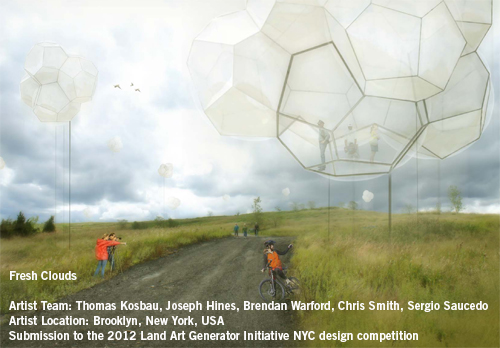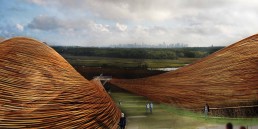Fresh Clouds
Submission to the 2012 Land Art Generator Initiative NYC design competition
Artist Team: Thomas Kosbau, Joseph Hines, Brendan Warford, Chris Smith, Sergio Saucedo
Artist Location: Brooklyn, New York, USA
www.oredesign.org

Artist Descriptive Text:
The Fresh Clouds project is built upon the concept of harvesting the byproducts of human consumption, through an innovative use of today’s technology and materials, into a resource stream.
From 1947 through 2001 the Fresh Kills Landfill received up to 29,000 tons of garbage a day*. Following the closure and capping of the Landfill, the original plan to build a recreation area over the 2,200 acre site was resumed.
The buried garbage is slowly digesting into poisonous and volatile methane gas deposits. The LAGI Competition Site, Area 3/4, is currently producing 19,000 cubic feet of methane gas per minute (CFM)* and is estimated to continue producing large amounts of methane through 2050. Currently a large portion of Fresh Kills Methane is piped to a 1988 era National Grid power generator. Even with the current generator burning 5 million cubic feet each day, enough methane to heat 25,000 homes, they cannot handle the methane load**. The resultant methane is burned off locally in onsite flues. Although the existing generator and flues dispose of the poisonous methane, current methods of burning convert it into greenhouse gases and air-pollutants such as carbon dioxide and nitrous oxide.
Fresh Clouds offers a scalable system that not only converts methane, but also cleans and converts the byproduct hot exhaust directly into energy at a local level. Creating energy directly at each well will reduce the required amount of infrastructure to ecologically convert methane to energy. Rather than building or maintaining a large network of gas infrastructure to a single distant electrical plant, Fresh Clouds propose installing micro-turbines at each passive well head, to continuously convert methane into electricity. The hot off-gassing of each micro-turbine flows into high temperature/pressure ETFE balloons.
The geometry of Fresh Clouds was created with a Weaire-Phelan packing script to mimick the structure of methane gas molecules under high pressure. The resultant shape provides optimal structural strength and minimum surface area for the hot gasses produced by the micro-turbines. The exterior layers of the Smart Clouds are composed of high strength ETFE. The interior, receiving high temperatures directly from the micro-turbines, is composed ETFE coated with titanium dioxide and PTFE, which absorbs the CO2 from the exhaust.
The high, internal temperatures of the Fresh Clouds, in comparison with ambient air temperature, result in a tremendous amount of lift. The base of each Cloud is tethered to three steel cables which run through flywheels that are arrayed around the micro-turbines, under an earthen enclosure. These tethering cables are pulled by the Cloud’s lift, causing the flywheels to generate a large amount of electricity. As the cloud approaches a FCC allowable maximum height of 500 ft, the cables pull taught and a series of vents open at the top of the cloud to release the cleaned hot exhaust. The internal temperature of the cloud returns to equilibrium and the cloud descends to the ground to repeat the process.


The electricity from the micro turbines and flywheels are fed directly into the NY metropolitan grid. The estimated sum of the 120 smart clouds, is enough to power 30,000 amount of NY households, which, given the smaller acreage of site 3/4 versus the entire site is over six times more power provided than the existing generator.
Of the 120 Fresh Clouds on site 3/4, dispersed along the existing pathway are 7 larger Clouds that function as floating Ecological Learning Centers. These also rise and fall due to the burning of methane but at a slower rate, pausing for 5 minutes of visitor loading/unloading at the ground level, and 15 minutes of interactive exhibits. Each of the learning has its own unique, but related ecological theme (Freshkills Renewal Project Interpretation; Local vs Global Consumption; Climate Change; Local vs Global Water Polution; New Technologies; Local vs Global Air Polution; and The Earth’s Future). During the ascent the visitor is engaged with interactive projections on the translucent and transparent skins of the Fresh Clouds. The ecological theme of each center is juxtaposed with the present day revitalization of Fresh Kills and the metropolis of the New York Metropolitan area beyond.
Like the smart grid, the smart cloud system not only supplies energy but also monitors energy usage in the NY metro area which is reflected in the color of leds, projecting an ambient glow in each cloud. The more energy used the brighter red, the field of occulting clouds will glow at night providing real time feedback visible to all in a 25 mile radius. As the metro NY area evolves into a more efficient ecological center in the years to come, the clouds will glow a cleaner white.
*Determination of Landfill Gas Composition and Pollutant Emission Rates at Fresh Kills Landfill; Carol Bellizzi; EPA – 1995; DCN 95-654-028-011
**Methane Brings New York $12 Million A Year As Dump Becomes Park; Mike Di Paola – Bloomberg – Aug 24, 2011

